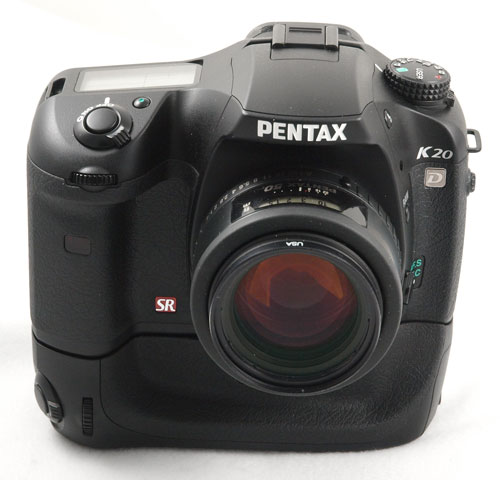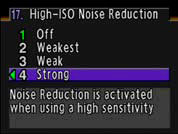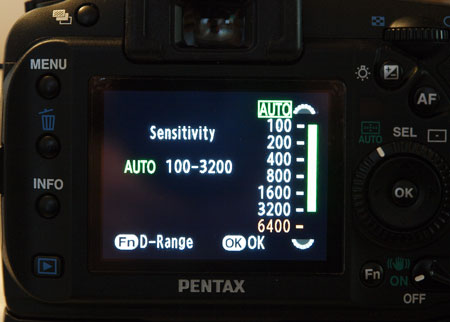Resolution and Image Quality

Our early impressions of the K20D were pretty positive with the fast Pentax 50mm f1.4. As always with recent screw-drive AF, the lens focusing is reasonably fast (if not blistering) and noise is much greater than the excellent Canon Ultrasonic motor lenses - which are now most of the better lenses in the Canon line. We had a K10D for comparison and the K20D seemed faster in AF, even though Pentax makes no claim of improvements in AF with the K20D.
The 14.6 MP CMOS sensor actually allows an ISO Boost to 6400, so the new ISO 3200 and ISO 6400 were the next features to tackle. By default the K20D high ISO noise reduction is set to off. This resulted in usable but grainy images at ISO 3200 and an ISO 6400 performance that was too coarse to be useful for our needs.

However, with the "weakest" and "weak" high ISO Noise Reduction settings, our first impressions in pixel-peeping high ISO images was much more favorable. The images with a small amount of noise reduction were pretty good - much better than we had expected. We had to wonder if early reviewers had noticed that high ISO noise reduction is completely off by default.
Images to ISO 1600 were quite good; 3200 shows deterioration in the shadow areas, but it is still very usable - even for large prints. ISO 6400 quality is better with a little NR and it would be usable for smaller prints or the web-posting we do, but too much is lost for large prints. All in all this is an outstanding performance for the new Samsung 14.6 MP sensor. Like many others, we wondered how good a new sensor from Samsung could be compared to Canon, Nikon, and Sony. More testing will be done in this area, but our first impressions are that the Samsung sensor is quite competitive, capturing more detail than the competing Nikon, Sony, Olympus, and Canon prosumer models.

Auto can be set to any ISO range you want, a feature Canon still refuses to implement fully. Based on early test shots we wouldn't hesitate to set the auto range from 100-1600 on a routine basis and 100-3200 if we were going into a low-light situation - or for times when the highest possible shutter speed is required. We would reserve 6400 for those special situations where the trade-offs make it worthwhile.
Whenever there is a recent Pentax is in our hands, we are again reminded of the usefulness of Hyperprogram, where you can instantly shift the aperture or shutter speed (front and rear dials) with the camera shifting other program parameters. Like the K10D, the K20D continues the unique TAv (Time & Aperture) Priority program, where you can select the shutter speed and the aperture which remain fixed while the program dynamically changes the ISO to maintain shutter speed and aperture. Selectable Auto ISO to 6400 on the one hand, and both TAv and Sv (Sensitivity or ISO) programs with the same range on the other hand, make the K20D a remarkably flexible digital SLR.










50 Comments
View All Comments
Wesley Fink - Tuesday, March 11, 2008 - link
There is hardly universal agreement with your 10 megapixel answer. This is from Brad Templeton in "How many pixels are there in a frame of 35mm film?" at http://pic.templetons.com/brad/photo/pixels.html">http://pic.templetons.com/brad/photo/pixels.html"This is a somewhat controversial question, and there are many possible answers. Film is an analog medium, so it doesn't have "pixels" per se, though film scanners have pixels and a specific resolution.
Today the one thing most people agree on is that it's a more than any current consumer digital camera. The debate is about how much resolution the digitals will have to reach to start matching the film.
The very short answer is that there are around 20 million "quality" pixels in a top-quality 35mm shot. That's a shot with a tripod, mirror-up, with a top-rate lens and the finest-grained film, in decent light. 12 million are more typical for "good" shots. There may be as few as 4 million "quality" pixels in a handheld shot with a point-and-shoot camera or camera with a poor lens. And of course if focus is poor, or light is poor, or the camera was not held steady, the number will drop down below the 1-2 million pixels of the modern consumer digicam. Of course, one can have a bad shot with a digital camera too, not using all its resolving ability. However, few pick their gear with the plan of shooting badly.
The eye, however, is not as discerning when looking at a picture in the usual context as it can be when looking at things blown up. So many can also argue that a shot of around 9 million pixels would look as good to the eye as a 35mm shot, except when blown up very large and looked at quite closely."
Wesley Fink - Tuesday, March 11, 2008 - link
www.clarkvision.com measured all formats and found 35mm Fujichrome Velvia required 10 megapixels to accurately portray color intensity but 16 megapixels to accurately portray color detail. Black & White Tech Pan required 16 megapixels to accurately convery the same information on a digital sensor.It is very interesting that Medium format (6x4.5mm) required a sensor resolution of 31 megapixels to 52 megapixels to convey the same information as Velvias on a medium format camera. Large format 8x10 view format required an amazing 600 to 960 megapixels to covey the same info.
It appears there are many opinions as to the true digital "equivalent" to 35mm resolution. The Pentax figure of 14.6 megapixels seems like a pretty good value in the ranges I have seen for 35mm film. However the equivalent resolution required for Medium Format and 8x10 View should amply show we have a long way to potentially go in sensor resolution.
spazmedia - Tuesday, March 11, 2008 - link
Thanks for the info. While the maximum resolution you quote from various websites is at around 16megapixels for film cameras (at iso50-100 it should be note) the sensor on the K20D as you well know is not 35mm. In any case for general purposes photography, you really don't need all that resolution (inc. landscapes). With film you also needed to deal with grain when enlarging, which is absent with all modern digital cameras. But camera makers need to sell cameras and increasing resolution is a sure fire way to do so.And you will never match medium/large formats in terms of resolution on an APS-c sensor as you are diffraction limited. Which makes increases in resolution even more useless.
But the most important, an you pointed this out very well, is that the new Pentax K20d is a joy to use. now if only I can justify to my wife why i need another camera!!!
Wesley Fink - Tuesday, March 11, 2008 - link
ISO is displayed in the Viewfinder when you select the Sensitivity (Sv) program. In this mode the ISO is underlined and you can adjust the ISO in half-steps (100, 140, 200, 280, 400, 560, 800, 1100, 1600, 2200, 3200, 4500, 6400) using the rear dial and see the changes in ISO in the viewfinder. As in other shift modes the ISO value blinks if an ISO you select is out of range for a correct exposure with the lens you are using.Cideway - Tuesday, March 11, 2008 - link
Hyper Program was first released in the Pentax Z1 in 1991. It consists of 2 dials and a green button, Front dial is Tv, rear dial is Av and the green button resets to the Program line. Turn either wheel at any time and you will change priority. The next element of HyP is the Program line its self, you have four options to choose from, Normal P, Hi P, Depth P and MTF P. Normal is as it says, while Hi is biased towards high shutter speeds, Depth is biased towards large DoF and MTF is biased towards the Lenses best aperture. (All Pentax Lens Designs are MTF tested and the data is encoded into the Lens, while FA* and DA*s are individually tested as are the FA and DA LTDs). I haven't used the Minolta system but nothing from Nikon or Canon quiet compares with HyP from Pentax.dug777 - Tuesday, March 11, 2008 - link
Aha!I understand the latter part of that explanation to be very different from what I am familiar with from Nikon(and pretty neat too).
Other than that, it appears the shifting priority is pretty convenient, using either dial.
Sensitivity Priority however, sounds exactly, 100% identical to what my Nikon does on Program Auto with a fixed ISO. You select an ISO value (check). You point the camera at on object. The camera picks what it considers to be the best aperture & shutter settings to maintain that ISO (check).
You can even then roll the main command dial to roll through different combinations of shutter speed and aperture which give the same exposure (which is a less simple version of those four program modes you describe, I don't know what 'biases' it works through there).
dug777 - Tuesday, March 11, 2008 - link
As far as I'm aware, most manufacturers offers variants of this. Shooting program auto, shutter priority, aperture priority, and full manual with my D80 I've a choice of locking the ISO, or allowing the camera to vary it.
Program auto lets the camera do everything, and rotating the main command dial in this mode lets you choose between different aperture/shutter combinations that produce the same exposure. On shutter priority, the camera controls the aperture, and vice versa for aperture priority. Finally on full auto you control the shutter & aperture (using the front & main command dials).
Wesley Fink - Tuesday, March 11, 2008 - link
In Pentax Program mode the front dial adjusts shutter speed and the rear dial adjusts aperture. When you click either dial the corresonding value you are adjusting is underlined in the viewfinder. Hyperprogram shifts the corresonding value to keep the same exposure, and it blinks if you select a value outside the exposure range. the shifted value survives an auto LED shutoff and remains underlined so you can instantly see what you shifted. You can turn off the shift and return to regular program mode by hitting the green dot button next to the shutter release and front dial.Most other companies now have some variation of this feature but the Pentax implementation is still the most logical, most complete, and easiest to use in my opinion.
Johnmcl7 - Tuesday, March 11, 2008 - link
I have to admit having read through the posts I don't see what is so much simpler about other manufacturers - on the Olympus E-3 when in program mode you turn the front dial and it switches to shutter priority (the display changes to Ps to show you've changed it). Alternatively if you want aperture priority you turn the rear dial, it won't let you underexpose (without using EV compensation) but that seems reasonable.However I think Panasonic have by far the simplest implementation on their L1 - it has a dedicated shutter dial and aperture dial (on Panasonic lenses), by default the aperture and shutter dials sit at 'A' which is full automatic control, the camera chooses both. If you want to choose shutter priority you just turn the shutter dial and the camera will work out an aperture for you. If you want aperture priority you turn the dial and choose an aperture, the camera will work out shutter speed if that's still on A. If you want full manual control just choose both an aperture and shutter value. Any time you want to switch back to automatic on either aspect you just turn the dial back, aside from being simple there's the obvious benefit that even with the camera powered down you can see what aperture/shutter is set to and also change it without switching the camera on.
John
Heidfirst - Tuesday, March 11, 2008 - link
I'll give you the Programme Sensitivity being unique but the rest doesn't seem too different to Minoltas going way back - my 1993 Dynax 700Si has it.